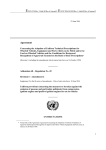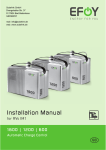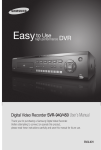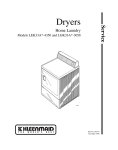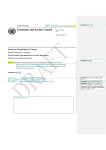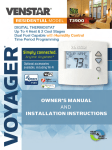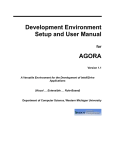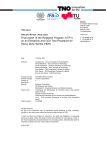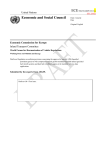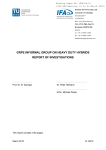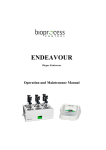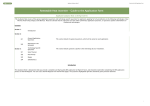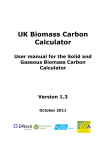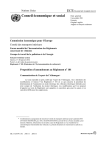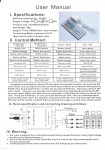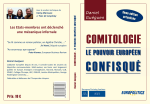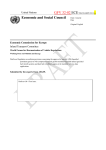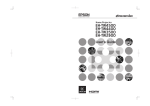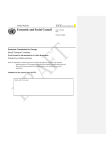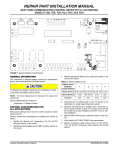Download Proposal for Supplement 2 to the 06 series of amendments
Transcript
United Nations
ECE/TRANS/WP.29/GRPE/2013/8
Economic and Social Council
Distr.: General
22 March 2013
Original: English
Economic Commission for Europe
Inland Transport Committee
World Forum for Harmonization of Vehicle Regulations
Working Party on Pollution and Energy
Sixty-sixth session
Geneva, 3-7 June 2013
Item 4(c) of the provisional agenda
UN Regulation No. 49 (emissions of compression ignition
and positive ignition (LPG and CNG) engines)
Proposal for Supplement 2 to the 06 series of amendments to
Regulation No. 49 (compression ignition and positive ignition
(LPG and CNG) engines)
Submitted by the expert of the European Commission*
The text reproduced below was prepared by the Euro VI Expert Working Group of
the European Commission. It introduced modifications to the 06 series of amendments of
UN Regulation No. 49 aiming to consider situations that were not addressed by the latest
series of amendments and to reduce the risks of misinterpretation or unclear text that have
been detected.
The modifications to the original English text are marked using track changes. The
same modifications in the French and Russian versions are marked in bold for new or
strikethrough for deleted characters.
* In accordance with the programme of work of the Inland Transport Committee for 2010–2014
(ECE/TRANS/208, para. 106 and ECE/TRANS/2010/8, programme activity 02.4), the World Forum
will develop, harmonize and update Regulations in order to enhance the performance of vehicles. The
present document is submitted in conformity with that mandate.
GE.13-
ECE/TRANS/WP.29/GRPE/2013/8
I. Proposal
Paragraph 2.52., amend to read:
"2.52.
"Qualified deteriorated component or system" (QDC) means a component or
system that has been intentionally deteriorated such as by accelerated ageing
or by having been manipulated in a controlled manner and which has been
accepted by the Type Approval Authority according to the provisions set out
in paragraph 6.3.2. of Annex 9B and paragraph A.8.2.2. of Appendix 8 to
Annex 9B to this Regulation for use when demonstrating the OBD
performance of the engine system;"
Paragraph 3.1.4., add a new item (i), to read:
"…
(h)
Where appropriate, copies of other type approvals with the relevant
data to enable extension of approvals and establishment of
deterioration factors;
(i)
Where appropriate, the documentation packages required by this
Regulation for the correct installation of the engine type-approved
as separate technical unit."
Paragraph 4.6.3., amend to read:
"4.6.3.
In the case of a natural gas/biomethane fuelled engines, including dual-fuel
engines, the manufacturer shall demonstrate the parent engines capability to
adapt to any natural gas/biomethane fuel composition that may occur across
the market. This demonstration shall be carried out according to this
section and, in case of dual-fuel engines, also according to the additional
provisions regarding the fuel adaptation procedure set out in section 6.4
of Annex 15 to this Regulation."
Paragraph 4.6.5., amend to read:
"4.6.5.
In the case of natural gas/biomethane engines, the ratio of the emission
results "r" shall be determined for each pollutant as follows:
…"
Paragraph 4.7., amend to read:
"4.7.
Requirements on restricted fuel range type-approval in case of positive
ignition engines fuelled with compressed natural gas/biomethane (CNG) or
LPG, including dual-fuel engines.
Restricted fFuel range restrictedtype approval shall be granted subject to the
requirements specified in paragraphs 4.7.1. to 4.7.2.3."
Paragraph 4.7.1., amend to read:
"4.7.1.
Exhaust emissions type-approval of an engine running on natural gasCNG
and laid out for operation on either the range of H-gases or on the range of Lgases."
Paragraph 4.7.2.1., amend to read:
"4.7.2.1.
2
The parent engine shall meet the emission requirements on the reference fuels
GR and G25 in the case of CNG, on the reference fuels GR and G20 in the
ECE/TRANS/WP.29/GRPE/2013/8
case of LNG,natural gas, or on the reference fuels A and B in the case of
LPG, as specified in Annex 5. Fine-tuning of the fuelling system is allowed
between the tests. This fine-tuning will consist of a recalibration of the
fuelling database, without any alteration to either the basic control strategy or
the basic structure of the database. If necessary the exchange of parts that are
directly related to the amount of fuel flow such as injector nozzles is
allowed."
Paragraph 4.7.2.2., amend to read:
"4.7.2.2.
In the case of CNG, aAt the manufacturer's request, the engine may be
tested on the reference fuels GR and G23, or on the reference fuels G25 and
G23, in which case the type-approval is only valid for the H-range or the Lrange of gases respectively."
Paragraph 4.7.2.3., amend to read:
"4.7.2.3.
On delivery to the customer the engine shall bear a label as specified in
paragraph 4.12.8. stating for which fuel range composition the engine has
been calibrated."
Paragraph 4.12.3.3.6., add new items (g), (h), and (i) and renumber items (g) and (h)
(former) into (j) and (k), to read:
"…
(f)
HLt in the case of the engine being approved and calibrated for a
specific gas composition in either the H-range or the L-range of gases
and transformable to another specific gas in either the H-range or the
L-range of gases by fine tuning of the engine fuelling;
(g)
CNGfr in all other cases where the engine is fuelled with
CNG/biomethane and designed for operation on one restricted gas
fuel range composition;
(h)
LNGfr in the cases where the engine is fuelled with LNG and
designed for operation on one restricted gas fuel range
composition;
(i)
LPGfr in the cases where the engine is fuelled with LPG and
designed for operation on one restricted gas fuel range
composition;
(gj)
LNG20 in case of the engine being approved and calibrated for a
specific liquefied natural gas / liquefied biomethane composition
resulting in a -shift factor not differing by more than 3 per cent the shift factor of the G20 gas specified in Annex 5, and the ethane content
of which does not exceed 1.5 per cent;
(hk)
LNG in case of the engine being approved and calibrated for any other
liquefied natural gas / liquefied biomethane composition."
Insert a new paragraph 4.12.3.4., to read:
"4.12.3.4.
In addition to the marking on the engine, the approval mark may also be
retrievable via the instrument cluster. It shall then be readily available
for inspection and the access instructions included in the user manual of
the vehicle."
Paragraph 4.12.8., amend to read:
3
ECE/TRANS/WP.29/GRPE/2013/8
"4.12.8.
Labels for natural gas/biomethane and LPG fuelled engines
In the case of natural gas and LPG fuelled engines with a restricted fuel
range restricted type-approval, the following labels are applicable:"
Paragraph 5.1.4.1., amend to read:
"5.1.4.1.
The documentation package required by paragraph 3. enabling the Approval
Authority to evaluate the emission control strategies and the systems onboard the vehicle and engine to ensure the correct operation of NOx control
measures, as well as the documentation packages required in Annex 10
(off-cycle emissions), Annexes 9A and 9B (OBD) and Annex 15 (dual-fuel
engines), shall be made available in the two following parts:
…"
Paragraph 5.1.4.3., amend to read:
"5.1.4.3.
The extended documentation package shall include:
(a)
information on the operation of all AES and BES, including a
description of the parameters that are modified by any AES and the
boundary conditions under which the AES operate, and indication of
which AES and BES are likely to be active under the conditions of the
test procedures set out in Annex 10;. The extended documentation
package shall include
(b)
a description of the fuel system control logic, timing strategies and
switch points during all modes of operation;. It shall also include
(c)
a full description of the inducement system required in Annex 11,
including the associated monitoring strategies;
(d)
the description of the anti-tampering measures considered in
section 3.1.4. (b) and in section 3.2.4. (a)."
Add a new paragraph 5.2.4., to read:
"5.2.4.
For the dilute testing of positive ignition engines by using an exhaust
dilution system, it is permitted to use analyser systems that meet the
general requirements and calibration procedures of Regulation No. 83.
In this case, the provisions of Section 9 and Appendix 2 to Annex 4 shall
not apply.
However, the test procedures in Section 7 of Annex 4 and the emission
calculations provided in Section 8 of Annex 4 shall apply."
Paragraph 5.3., table 1 and notes, amend to read:
"5.3.
Emission limits
Table 1 provides the emissions limits that apply to this Regulation.
4
ECE/TRANS/WP.29/GRPE/2013/8
Table 1
Emission Limits
Limit values
PM
CO
THC
NMHC
CH4
NOX
NH3 PM mass
number
(mg/kWh) (mg/kWh) (mg/kWh) (mg/kWh) (mg/kWh) (ppm) (mg/kWh)
(#/kWh)
8.0 x
WHSC (CI)
1,500
130
400
10
10
1011 *
6.0 x
WHTC (CI)
4,000
160
460
10
10
1011 **
WHTC (PI)
4,000
160
500
460
10
10
Notes:
PI = Positive Ignition
CI = Compression Ignition
*
[Until the implementation date, new types, specified in row C of table 1 in
Annex 3, the applicable emission limit shall be 8,0 x 1011 #/kWh]
**
[Until the implementation date, new types, specified in row C of table 1 in
Annex 3, the applicable emission limit for ED95 engine shall be 6,0 x 1013
#/kWh]
Note:
PI =
Positive Ignition
CI =
Compression Ignition"
Paragraph 6.2., split into 6.2. and 6.2.1. and amend to read:
"6.2.
Installation of a type-approved engine on a vehicle
6.2.1.
The installation of an engine type-approved as a separate technical unit on a
vehicle shall, in addition, comply with the following requirements:
(a)
As regard to the compliance of the OBD system, the installation shall,
according to Appendix 1 of Annex 9B, meet the manufacturer's
installation requirements as specified in Part 1 of Annex 1;
(b)
As regard to the compliance of the system ensuring the correct
operation of NOx control measures, the installation shall, according to
Appendix 4 of Annex 11, meet the manufacturer's installation
requirements as specified in Part 1 of Annex 1.;
(c)
The installation of a dual-fuel engine type-approved as a separate
technical unit on a vehicle shall, in addition, meet the specific
installation requirements and the manufacturer's installation
requirements set out in Annex 15."
Paragraph 6.2.1. (former), delete.
Paragraphs 8.3.3.3 and 8.3.3.4., amend to read:
"8.3.3.3.
For diesel, ethanol (ED95), petrol, E85, LNG20, LNG and LPG fuelled,
including dual-fuel, engines, all these tests may be conducted with the
applicable market fuels. However, at the manufacturer’s request, the
reference fuels described in Annex 5 may be used. This implies tests, as
described in paragraph 4, with at least two of the reference fuels for each gas
engine.
8.3.3.4.
For natural gas fuelledCNG engines, including dual-fuel engines, all these
tests may be conducted with market fuel in the following way:
…"
5
ECE/TRANS/WP.29/GRPE/2013/8
Paragraph 8.3.3.5., amend to read:
"8.3.3.5.
Non-compliance of gas engines
In the case of dispute caused by the non-compliance of gas fuelled engines,
including dual-fuel engines, when using a market fuel, the tests shall be
performed with aeach reference fuel on which the parent engine has been
tested, orand, at the request of the manufacturer, with the possible
additional third fuel 3, as referred to in paragraphs 4.6.4.1. and 4.7.1.2., on
which the parent engine may have been tested.
ThenWhen applicable, the result shall be converted by a calculation,
applying the relevant factors «"r», ", «"ra» " or «"rb» " as described in
paragraphs 4.6.5., 4.6.6.1. and 4.7.1.3.. If r, ra or rb are less than 1, no
correction shall take place.
The measured results and, when applicable, the calculated results shall
demonstrate that the engine meets the limit values with all relevant fuels (for
example fuels 1, 2 and, if applicable, the third fuel 3 in the case of natural
gas engines, and fuels A and B in the case of LPG engines)."
Paragraphs 8.4.1., 8.4.2, and 8.4.3., amend to read:
"8.4.1.
…
An engine shall be randomly taken from series production and subjected to
the tests described in Annex 9B and in the case of dual-fuel engines to the
additional tests required by Section 7 of Annex 15. The tests may be
carried out on an engine that has been run-in up to a maximum of 125 hours.
8.4.2.
The production is deemed to conform if this engine meets the requirements of
the tests described in Annex 9B and in the case of dual-fuel engines to the
additional tests required by Section 7 of Annex 15.
8.4.3.
If the engine taken from the series production does not satisfy the
requirements of paragraph 8.4.1., a further random sample of four engines
shall be taken from the series production and subjected to the tests described
in Annex 9B and in the case of dual-fuel engines to the additional tests
required by Section 7 of Annex 15. The tests may be carried out on engines
that have been run-in, up to a maximum of 125 hours."
Annex 1, table in Part 1, amend to read:
"
…
3.2.1.1.1.
3.2.1.1.2.
…
3.2.1.6.2.
3.2.2.2.
…
3.2.9.3.
6
…
Type of dual-fuel engine:
Type 1A/Type 1B/Type 2A/Type 2B/Type 3B1,14
Gas Energy Ratio over the hot part of the WHTC test-cycle14:
…………….%
Gas Energy Ratio over the hot part of the WHTC test-cycle:
…………….%14
…
Idle on Diesel: yes/no 1,14
Heavy duty vehicles Diesel/Petrol/LPG/NG-H/NG-L/NGHL/Ethanol (ED95)/ Ethanol (E85)/LNG/LNG20dual fuel 1,15
…
Maximum allowable exhaust back pressure at rated engine speed
and at 100 % load (compression ignition engines only) (kPa)7
ECE/TRANS/WP.29/GRPE/2013/8
3.2.9.7.
3.2.9.7.1.
…
3.2.12.2.7.0.5.
3.2.12.7.0.6.
…
3.2.12.2.8.1.
3.2.12.2.8.2.
3.2.12.2.8.2.1.
3.2.12.2.8.2.2.
3.2.12.2.8.3.
3.2.12.2.8.4.3.1.
Exhaust system volume (dm³)
Acceptable Eexhaust system volume (vehicle and engine
system): (dm³)
…
When appropriate, manufacturer reference of the Documentation
for installing in a vehicle an OBD equipped engine system
When appropriate, manufacturer reference of the documentation
for installing the dual-fuel engine in a vehicle
…
Systems to ensure the correct operation of NOx control measures
Driver inducement system
Engine with permanent deactivation of the driver inducement, for
use by the rescue services or in vehicles designed and constructed
for use by the armed services, civil defence, fire services and
forces responsible for maintaining public order: Yes/No1
Activation of the creep mode 'disable after restart'/'disable
after fuelling'/'disable after parking'1,7
Number of OBD engine families within the engine family
considered when ensuring the correct operation of NOx control
measures
List of the OBD engine families within the engine family
considered when ensuring the correct operation of NOx
control measures (when applicable)
3.2.12.2.8.5.3.2.
Number of the OBD engine family the parent engine / the engine
member belongs to
3.2.12.2.8.5.
Heated/non-heated reagent tank and dosing system (see point
2.4 of Annex 11)
3.2.12.2.8.6.
Lowest concentration of the active ingredient present in the
reagent that does not activate the warning system (CDmin) (% vol)
…
3.2.17.
…
Specific information related to gas fuelled engines and dual fuel
engines for heavy-duty vehicles (in the case of systems laid out in
a different manner, supply equivalent information) (if applicable)
…
…
3.2.17.9.
When appropriate, manufacturer reference of the
documentation for installing the dual-fuel engine in a vehicle14
3.5.4.
CO2 emissions for heavy duty engines
3.5.4.1.
CO2 mass emissions WHSC test16: ………………… (g/kWh)
For dual-fuel engines, CO2 mass emissions WHSC test in diesel
mode1317: …………………………g/kWh
For dual-fuel engines, CO2 mass emissions WHSC test in dualfuel mode13 (if applicable): ………………………… g/kWh
CO2 mass emissions WHSC test in dual-fuel mode14 (if
applicable): ………………………… g/kWh
3.5.4.1.1.2.
3.5.4.3.
OBD engine family 1:
………….
OBD engine family 2:
………….
etc…
7
ECE/TRANS/WP.29/GRPE/2013/8
CO2 mass emissions WHTC test16: ………………… (g/kWh)
For dual-fuel engines, CO2 mass emissions WHTC test in diesel
mode1317: ………………………… g/kWh
For dual-fuel engines, CO2 mass emissions WHTC test in dualfuel mode13: ………………………… g/kWh
CO2 mass emissions WHTC test in dual-fuel mode14
………………………… g/kWh
Fuel consumption for heavy duty engines
3.5.4.2.4.
3.5.4.2.1.5.
3.5.4.6.
3.5.5.
Fuel consumption WHSC test16: ………………… (g/kWh)
For dual-fuel engines, fFuel consumption WHSC test in diesel
mode1317: ………………………… g/kWh
For dual-fuel engines, fuel consumption WHSC test in dual-fuel
mode13: ………………………… g/kWh
Fuel consumption WHSC test in dual-fuel mode14:
………………………… g/kWh
Fuel consumption WHTC test5,16: ………………… (g/kWh)
For dual-fuel engines, fFuel consumption WHTC test in diesel
mode13: ………………………… g/kWh
For dual-fuel engines, fuel consumption WHTC test in dual-fuel
mode13: ………………………… g/kWh
Fuel consumption WHTC test in dual-fuel mode 14:
………………………… g/kWh
…
3.5.5.1.
3.5.5.1.1.2.
3.5.5.3.
3.5.5.2.4.
3.5.5.2.1.5.
3.5.5.6.
…
"
Annex 1, table in Part 2, amend to read:
"
…
…
3.2.2.4.1.
Dual-fuel vehicle: yes/no1
…
…
3.2.9.7.
Complete eExhaust system volume (vehicle and engine system)
(dm³)
Actual volume of the complete Exhaust system (vehicle and
engine system) (dm³)
3.2.9.7.1.
3.2.12.2.7.
On-board-diagnostic (OBD) system
3.2.12.2.7.8.
OBD features related to the vehicle
3.2.12.2.7.8.0.
Alternative approval as defined in paragraph 2.4. of Annex 9A of
this Regulation used: Yes/No1
3.2.12.2.7.8.1.
OBD components on-board the vehicle
3.2.12.2.7.8.2.
When appropriate, manufacturer reference of the documentation
package related to the installation on the vehicle of the OBD
system of an approved engine
3.2.12.2.7.8.3.
Written description and/or drawing of the MI10
8
ECE/TRANS/WP.29/GRPE/2013/8
3.2.12.2.7.8.4.
Written description and/or drawing of the OBD off-board
communication interface10
3.2.12.2.7.8.5.
OBD Communication protocol standard:4
3.2.12.2.8.1.
Systems to ensure the correct operation of NOx control measures
3.2.12.2.8.1.0.
NOx control systems features related to the vehicle
3.2.12.2.8.1.0.1.
Alternative approval as defined in paragraph 2.1. of Annex 1111
of this Regulation used. Yes/No1
3.2.12.2.8.1.0.2.
List of cComponents on-board the vehicle of the systems
ensuring the correct operation of NOx control measures
3.2.12.2.8.2.1.0.3.
Activation of the creep mode:
"disable after restart" / "disable after fuelling" / "disable after
parking"12
3.2.12.2.8.3.1.0.4.
When appropriate, manufacturer reference of the documentation
package related to the installation on the vehicle of the system
ensuring the correct operation of NOx control measures of an
approved engine
3.2.12.2.8.4.1.0.5.
Written description and/or drawing of the warning signal10
3.2.12.2.8.5.1.0.6.
Heated/non heated reagent tank and dosing system (see paragraph
2.4. of Annex 11 of this Regulation)
"
Annex 1, notes following the table in Part 2, amend to read:
"…
13
14
15
16
17
When required by this RegulationDual fuel engines.
In case of a dual-fuel engine or vehicle (types as defined in Annex 15).
In case of a dual-fuel engine or vehicle, the type of gaseous fuel used in dual-fuel mode shall
not be struck out.
Except for dual-fuel engines or vehicles (types as defined in Annex 15).
In the case of Type 1B, Type 2B, and Type 3B of dual-fuel engines (types as defined in
Annex 15)."
Annex 1, Appendix to information document, paragraph 5.1., amend to read (including the
new footnote † and deleting the footnote *):
"5.1.
Engine test speeds for emissions test according to aAnnex 42,† or engine test
speeds for emissions test in dual-fuel mode according to Annex 4 2,*
…
______________________
†
In the case of dual-fuel engines of Type 1B, Type 2B, and Type 3B, types as defined in Annex
15, repeat the information in both dual-fuel and diesel mode."
Annex 1, Appendix to information document, paragraph 5.1.1., delete (including the
footnotes * and **).
Annex 1, Appendix to information document, paragraph 5.2., amend to read:
"5.2.
Declared values for power test according to Regulation No. 85 or declared
†*
values for power test in dual-fuel mode according to Regulation No. 85
…"
9
ECE/TRANS/WP.29/GRPE/2013/8
Annex 1, Appendix to information document, paragraphs 5.2.6 to 5.2.6.5., delete (including
the footnotes * and **).
Annex 2A and 2C, Addendum to Type-approval Communication, paragraphs 1.1.5. and
1.1.5.1., amend to read (including the new footnote † and deleting the footnote *):
"1.1.5.
Category of engine: Diesel/Petrol/LPG/NG-H/NG-L/NG-HL/Ethanol
(ED95)/ Ethanol (E85)/LNG/LNG20dual fuel1
1.1.5.1.
Type of dual-fuel engine: Type 1A/Type 1B/Type 2A/Type 2B/Type 3B1,†*
______________________
*
†
In case of a dual-fuel engine or vehicle (types as defined in Annex 15).
Dual fuel engines."
Annex 2A and 2C, Addendum to Type-approval Communication, para. 1.4., amend to read:
"1.4
Emission levels of the engine/parent engine1
Deterioration Factor (DF): calculated/fixed1
Specify the DF values and the emissions on the WHSC (if applicable) and
WHTC tests in the table below.
In case of engines tested on different reference fuels, the tables shall be
reproduced for each reference fuel tested.
In case of Type 1B and Type 2B dual-fuel engines, the tables shall be
reproduced for each mode tested (dual-fuel and diesel modes)."
Annex 2A and 2C, Addendum to Type-approval Communication, table 4, amend to read
(including new notes *, **, and ‡ and deleting the former footnote **):
"Table 4
WHSC test
WHSC test (if applicable)*,**
DF
Mult/add1
Emissions
CO
THC
NMHC‡**
NOX
PM Mass
NH3
PM
Number
CO
(mg/kWh)
THC
(mg/kWh)
NMHC‡**
NOX
(mg/kWh)
PM Mass
(mg/kWh)
NH3
ppm
PM
Number
(#/kWh)
Test result
Calculated with DF
(mg/kWh)
CO2 emissions mass emission**: ………..………………….…….g/kWh
Fuel consumption**: ……………………………………………..g/kWh
*
In the case of engines considered in sections 4.6.3 and 4.6.6 of this Regulation, repeat the information for
all fuels tested, when applicable.
**
In the case of dual-fuel engines of Type 1B, Type 2B, and Type 3B, types as defined in Annex 15, repeat
the information in both dual-fuel and diesel mode.
‡
In the cases laid down in table 1 of Annex 15 for dual-fuel engines, and for positive ignition engines.
______________________
**
10
When required by this Regulation."
ECE/TRANS/WP.29/GRPE/2013/8
Annex 2A and 2C, Addendum to Type-approval Communication, table 5, amend (including
new notes *, **, and ‡ and deleting the references to the former footnote **)to read:
"Table 5
WHTC Test
WHTC test*,**
DF
CO
THC**
NMHC‡**
CH4‡**
NOx
PM Mass
NH3
PM
Number
CO
(mg/kWh)
THC**
(mg/kWh)
NMHC‡**
(mg/kWh)
CH4‡**
(mg/kWh)
NOx
(mg/kWh)
PM Mass
(mg/kWh)
NH3
ppm
PM
Number
(#/kWh)
Mult/add1
Emissions
Cold start
Hot start w/o
regeneration
Hot start with
regeneration(1)
kr,u (mult/add)
1
kr,d (mult/add)
1
Weighted test
result
Final test
result with DF
CO2 emissions mass emission**:..………………...…………….g/kWh
Fuel consumption**: ……………………………………………..g/kWh
*
**
‡
In the case of engines considered in sections 4.6.3 and 4.6.6 of this Regulation, repeat the information for
all fuels tested, when applicable.
In the case of dual-fuel engines of Type 1B, Type 2B, and Type 3B, types as defined in Annex 15, repeat
the information in both dual-fuel and diesel mode.
In the cases laid down in table 1 of Annex 15 for dual-fuel engines, and for positive ignition engines.
"
Annex 4, paragraph 6.11.1., amend to read:
"6.11.1.
The pressure in the crankcase shall be measured over the emissions test
cycles at an appropriate location. It shall be measured at the dip-stick hole
with an inclined-tube manometer.
6.11.1.1.
The pressure in the intake manifold shall be measured to within ±1 kPa.
6.11.1.2.
The pressure measured in the crankcase shall be measured to within ±
0,01 kPa."
Annex 6, paragraph 1.1., amend to read:
"1.1.
This annex sets out the procedure for measuring carbon monoxide emissions
at idling speeds (normal and high) for positive ignition engines fuelled with
petrol or ethanol (E85) or positive ignition engines fuelled with
NG/Biomethane or LPG installed in M2, N1 or M1 vehicles of category M1
with a technically permissible maximum laden maximum permissible mass
not exceeding 7.5 tonnes, as well as in vehicles of categories M2 and N1."
Annex 6, add a new paragraph 1.2., to read:
11
ECE/TRANS/WP.29/GRPE/2013/8
"1.2.
This Annex does not apply to dual-fuel engines and vehicles."
Annex 7, add a new paragraph 3.3.2.4., to read:
"3.3.2.4.
The use of market fuels is allowed for conducting the service
accumulation schedule. A reference fuel shall be used to carry out the
emission test."
Annex 8, add new paragraphs 4.6.6.1.and 4.6.6.2., to read:
"4.6.6.1.
As an alternative the electrical power to the PEMS system may be
supplied by the internal electrical system of the vehicle as long as the
power demand for the test equipment does not increase the output from
the engine by more than 1% of its maximum power and measures are
taken to prevent excessive discharge of the battery when the engine is not
running or idling.
4.6.6.2.
In case of a dispute the results of measurements performed with a PEMS
system powered by an external power supply shall prevail over the
results acquired according to the alternative method under 4.6.6.1."
Annex 8, paragraph 5.1.2., amend to read:
"5.1.2.
Torque signal
5.1.2.1.
The conformity of the torque signal calculated by the PEMS equipment from
the ECU data-stream information required in paragraph 9.4.2.1. of this
Regulation shall be verified at full load."
Annex 8, paragraph 5.1.2.1. (former), renumber as 5.1.2.1.1.
Annex 8, add new paragraph 5.1.2.4., to read:
"5.1.2.4.
Dual-fuel engines and vehicles shall, in addition, comply with the
requirements and exceptions related to the torque correction set out in
Annex 15."
Annex 8, Appendix 1, table 1, note 4, amend to read:
"4
The recorded value shall be either (a) the net brake engine torque according to section
A.1.2.4.4. of this Appendix or (b) the net brake engine torque calculated from the torque
values according to section A.1.2.4.4. of this Appendixthe actual engine per cent torque, the
friction torque and the reference torque, according to the SAE J1939-71 standard."
Annex 8, Appendix 1, paragraph A.1.2.4.4. amend to read:
"A.1.2.4.4.
Connection with the vehicle ECU
A data logger shall be used to record the engine parameters listed in Table 1.
This data logger can make use of the Control Area Network (hereinafter
CAN) bus of the vehicle to access the ECU data specified in Table 1 of
Appendix 5 of Annex 9B and broadcasted on the CAN according to
standard protocols such as SAE J1939, J1708 or ISO 15765-4. It may
calculate the net brake engine torque or perform unit conversions."
Annex 8, Appendix 1, paragraph A.1.2.5.3. amend to read:
"A.1.2.5.3.
Checking and calibrating the analysers
The zero and span calibration and the linearity checks of the analysers shall
be performed using calibration gases meeting the requirements of
paragraph 9.3.3. of Annex 4. A linearity check shall have been performed
within three months before the actual test."
12
ECE/TRANS/WP.29/GRPE/2013/8
Annex 8, Appendix 2, paragraph A.2.2.3. amend to read:
"A.2.2.3.
Sampling of gaseous emissions
The sampling probes shall meet the requirements defined in
paragraphs A.2.1.2. and A.2.1.3. of Appendix 2 to Annex 4. The sampling
line shall be heated to 190 °C (+/-10°C)."
Annex 9B, paragraph 4.5., insert an example and amend to read:
"4.5.
Requirements for malfunction classification
…
If a malfunction would result in a different classification for different
regulated pollutant emissions or for its impact on other monitoring capability,
the malfunction shall be assigned to the class that takes precedence in the
discriminatory display strategy (for example Class A takes precedence
over Class B1).
…"
Annex 9B, paragraph 4.5.1., amend to read:
"4.5.1.
Class A malfunction
A malfunction shall be identified as Class A when the relevant OBD
threshold limits (OTLs) are assumed to be exceeded.
It is accepted that tThe emissions may still remain below not be above the
OTLs when this class of malfunction occurs."
Annex 9B, paragraph 4.7.1.5.1., amend to read:
"4.7.1.5.1.
The manufacturer may request, subject to approval by the Type Approval
Authority, that the ready status for a monitor to be set to indicate "complete"
without the monitor having run and concluded the presence or the absence of
the failure relevant to that monitor.
Such a request may only be approved, if duringmonitoring is disabled for
a multiple number of operating sequences (minimum 9 operating sequences
or 72 operation hours):
(a)
monitoring is temporarily disabled according to paragraph 5.2. of
this Annex due to the continued presence of extreme operating
conditions (e.g. cold ambient temperatures, high altitudes); or
(b)
the system that is monitored is not in operation and the DTC
associated to that system do not have the confirmed and active or
the previously active status at the time when the readiness status
becomes incomplete during a repair.
Any such request must specify the conditions for monitoring system
disablement and the number of operating sequences that would pass without
monitor completion before ready status would be indicated as "complete".
The extreme ambient or altitude conditions considered in the manufacturer's
request shall never be less severe than the conditions specified by this annex
for temporary disablement of the OBD system."
Annex 9B, paragraph 5.2.2., insert a new item (e) to read:
"5.2.2.
Ambient temperature and altitude conditions
13
ECE/TRANS/WP.29/GRPE/2013/8
Manufacturers may request approval to disable OBD system monitors:
…
(d)
At elevations above 2,500 meters above sea level; or
(e)
Below 400 meters under sea level."
Annex 9B, Appendix 3, Item 1, amend to read:
"Appendix 3 - Item 1
…
Wherever a feedback control loop exists, the OBD system shall monitor the system's ability
to maintain feedback control as designed (possible errors are for example: not e.g. to
entering feedback control within a manufacturer specified time interval, or: whensystem
fails to maintain feedback control, feedback control has used up all the adjustment
capability allowed by the manufacturer and the system cannot achieve the target) component monitoring.
…"
Annex 9B, Appendix 3, Item 2, amend to read:
"Appendix 3 - Item 2
…
(c1)
DPF filtering performance: the filtering and continuous regeneration process of the
DPF. This requirement would apply to PM emissions only - emission threshold
monitoring.
…"
Annex 9B, Appendix 3, Item 3, amend to read:
"Appendix 3 - Item 3
…
(b)
Active/intrusive reagent: the on-board availability of the reagent, the proper
consumption of the reagent if a reagent other than fuel is used (e.g. urea) performance monitoring;
…"
Annex 9B, Appendix 5, table 1, amend to read (also adding new lines):
"Table 1
Mandatory requirements
Freeze frame
Data stream
Calculated load (engine torque as a percentage of maximum
torque available at the current engine speed)
x
X
Engine speed
x
x
Engine coolant temperature (or equivalent)
x
X
Barometric pressure (directly measured or estimated)
x
x
Reference maximum engine torque
14
x
ECE/TRANS/WP.29/GRPE/2013/8
Net brake engine torque (as a percentage of reference
maximum engine torque), or
x
Actual engine torque / indicated torque (as a percentage of
reference maximum engine torque, e.g. calculated from
commanded injection fuel quantity)
Friction torque (as a percentage of reference maximum
engine torque)
x
Engine fuel flow
x
"
Annex 9B, Appendix 5, table 2, amend to read (deleting one line):
"Table 2
Optional engine speed and load information
Freeze frame
Data stream
Driver’s demand engine torque (as a percentage of maximum
engine torque)
x
x
Actual engine torque (calculated as a percentage of maximum
engine torque, e.g. calculated from commanded injection fuel
quantity)
x
x
Reference engine maximum torque
x
Reference maximum engine torque as a function of engine
speed
X
Time elapsed since engine start
x
X
"
Annex 9C, paragraph 4.1.1., amend to read:
"4.1.1.
Groups of monitors
…
Manufacturers are not required to implement software algorithms in the OBD
system to individually track and report in-use performance data of monitors
running continuously as defined in paragraph 4.2.3. of Annex 9B if these
monitors are already part of one of the groups of monitors mentioned in
Appendix 1 to this annex."
Annex 10, paragraph 11, amend to read:
"11.
Documentation
The Type Approval Authority may decide toshall require that the
manufacturer provides a documentation package. This should describe any
element of design and emission control strategy of the engine system and the
means by which it controls its output variables, whether that control is direct
or indirect.
The information may shall include a full description of the emission control
strategy. In addition, this could include information on the operation of all
AES and BES, including a description of the parameters that are modified by
15
ECE/TRANS/WP.29/GRPE/2013/8
any AES and the boundary conditions under which the AES operate, and
indication of which AES and BES are likely to be active under the conditions
of the test procedures in this annex.
This documentation package shall be provided according to the
provisions of section 5.1.4.3. of this Regulation."
Annex 11, paragraph 5.3., add footnote 2 to read:
"5.3.
Low-level inducement system
The low-level inducement system shall reduce the maximum available engine
torque across the engine speed range by 25 per cent between the peak torque
speed and the governor breakpoint as described in Appendix 3 to this annex.
The maximum available reduced engine torque below the peak torque speed
of the engine before imposition of the torque reduction shall not exceed the
reduced torque at that speed.
The low-level inducement system shall be activated when the vehicle
becomes stationary2 for the first time after the conditions specified in
paragraphs 6.3., 7.3., 8.5. and 9.4., have occurred.
______________________
2
A vehicle shall be considered as stationary at the latest 1 minute after operation of the vehicle
speed has been reduced to zero km/h. The engagement of any device such as a park-brake, a
trailer-brake, or a hand-brake shall not be necessary for being stationary."
Annex 11, paragraph 5.4.4, add footnote 2 to read:
"5.4.4.
A "disable on time limit" system shall limit the vehicle speed to 20 km/h
("creep mode") on the first occasion when the vehicle becomes stationary2
after eight hours of engine operation if none of the systems described in
paragraphs 5.4.1. to 5.4.3. has been previously been activated."
Annex 11, Appendix 5, paragraph A.5.3.1., amend to read:
"A.5.3.1.
The "NOx control information" shall contain at least the following
information:
…
(g)
The DTCs associated with the malfunctions relevant to this annex and
when their status is 'potential' or 'confirmed and active'their status
(“potential”, “confirmed and active”, etc.)."
Annex 15, the title, amend to read:
"Additional
tTechnical requirements for diesel-gas dual-fuel
engines and vehicles"
Annex 15, paragraph 4.3.1.2., amend to read:
"4.3.1.2.
16
The dual-fuel mode indicator shall be set for at least one minute on dualfuel mode or diesel mode as soon as the engine operating mode is
changed from diesel to dual-fuel mode or vice-versa. This indication is
also required for at least one minute at key-on, or at the request of the
manufacturer at engine cranking. The indication shall also be given upon
the driver’s request.The dual-fuel mode indicator shall be set for at least one
minute on dual-fuel mode or diesel mode as soon as the engine operates on
ECE/TRANS/WP.29/GRPE/2013/8
dual-fuel or on diesel mode. This indication is required at key-on for at least
1 minute. The indication shall also be given upon driver's request."
Annex 15, paragraph 5.4., amend to read:
"5.4.
Conformity factors
PrincipallyIn principle, the emission limit applicable for applying the
conformity factor used when performing a PEMS test, whether a PEMS test
at certification or a PEMS test when checking and demonstrating the
conformity of in-service engines and vehicles, shall should be determined on
the basis of the actual GER calculated from the fuel consumption measured
over the on-road test.
However, in absence of a robust way to measure the gas or the diesel fuel
consumption, the manufacturer is allowed to use the GERWHTC determined on
the hot part of the WHTC and calculated according to this annex."
II. Justification
1.
The Expert Group on the third Euro VI comitology package, set up by the
Commission, is currently developing the amendments that need to be implemented in
Euro VI in order to align it to UN Regulation No. 49. During the discussions, the group has
identified a certain number of aspects that would need to be changed in UN Regulation
No. 49. For instance, cases that were not addressed by the latest series of amendments have
been revealed. Risks of misinterpretation or unclear text have also been detected.
2.
The present document aims at introducing the appropriate changes, which
include, among others, the following aspects: (a) editorial corrections in order to clarify the
requirements for the type-approval of gas and dual-fuel engines; (b) improvement of the
requirements on the information package to be handed over to type-approval authorities,
including the information document; (c) Amendment of some specifications on emissions
testing; and (d) introduction of some OBD provisions in Annexes 9B and 9C,
complementing the existing ones.
17

















